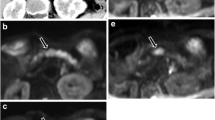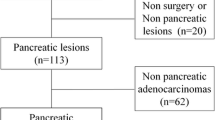Abstract
Purpose
The aim of this study was to demonstrate the feasibility of body diffusion-weighted (DW) MR imaging in the evaluation of a pancreatic carcinoma.
Material and methods
In nine normal volunteers and in eight patients with pancreatic carcinoma, DW images were obtained on the axial plane scanning with a multisection spin-echo-type single-shot echo planar sequence with a body coil. Moreover, we measured the apparent diffusion coefficient (ADC) value in a circular region of interest (ROI) within the normal pancreas, pancreatic carcinoma, and tumor-associated chronic pancreatitis.
Results
On the DW images, all eight carcinomas were clearly shown as high signal intensity relative to the surrounding tissue. The ADC value (×10−3 mm2/s) in the carcinoma was 1.44 ± 0.20, which was significantly lower compared to that of normal pancreas (1.90 ± 0.06) and tumor-associated chronic pancreatitis (2.31 ± 0.18).
Conclusion
Diffusion-weighted (DW) images can be helpful in detecting the pancreatic carcinoma and accessing the extent of the tumor.
Similar content being viewed by others
Explore related subjects
Discover the latest articles, news and stories from top researchers in related subjects.Avoid common mistakes on your manuscript.
The utilization of diffusion-weighted (DW) MR imaging in the abdomen was attractive in the detection of the malignant tumors, such as malignant hepatic, renal, prostatic, colonic, and uterine cervical tumors [1]. However, its application to the abdomen has been hindered in the presence of bulky physiologic motions such as respiration, peristalsis, and blood flow. Therefore, to reduce respiratory motion, breath holding under the examination is required. Such an approach limits the acquisition time, and both the signal-to-noise ratio and the spatial resolution must be compromised as a result. For resolving those defaults, Takahara et al. [2] reported a body DW MR imaging under free breathing, which affords a longer scan time. This technique gives more and thin slice images with multiple signals averaging. In this study, we discussed the feasibility of DW MR imaging under free breathing in the evaluation of a pancreatic carcinoma.
Material and methods
Nine normal volunteers and eight consecutive patients (six women and two men; age range 59–73 years; mean 66 years) with histopathologically proven pancreatic adenocarcinoma by surgery were examined. One patient underwent FDG PET/CT examination. The carcinomas were in the pancreatic uncus or head in three patients, in the body in four patients, and in the tail in one patient. The diameter of the tumors ranged from 13.2 to 33.6 mm (mean 20.8 mm). Normal volunteers and patients were scanned using a 1.5-T MRI scanner (SIGNA MR/I Echo Speed 1.5 T CV Option, General Electric Medical Systems, Milwaukee, WI, USA). DW MR images were obtained using a multisection spin-echo-type, single-shot echo planar on the axial plane under free breathing scanning with a body coil. It was designed with the following parameters; TR/TE = 7500/68 ms, band width = 143 kHz, 128 × 128 matrix, slice thickness of 5 mm, intersection gap of 0 mm, 480 × 480 mm FOV, seven excitations, water excitation with b value of 0 and 800 s/mm2. The MPG pulses were placed in the X-, Y- and Z-axes. Respiratory trigger was not used. Thirty-four slices were obtained in 190 s. Imaging analyses were as follows. (a) The identification of the pancreatic carcinomas on DW images was determined in the comparison of the operative findings. (b) The apparent diffusion coefficient (ADC) values of the eight carcinomas and the four tumor-associated pancreatitis in eight patients and the nine normal pancreases in nine normal volunteer were calculated and compared. The ADC values (× 10−3 mm2/s) were calculated as follows: ADC = (1/(b1 − b0)) In(S0/S1). To compare ADC values among them, an unpaired t-test was used. P < 0.05 was considered as statistically significant.
Results
On the DW images, all eight carcinomas were clearly shown as high signal intensity relative to the surrounding tissue (Fig. 1). The mean and standard deviations of the ADC values (× 10−3 mm2/s) were as follows: carcinomas (n = 8), 1.43 ± 0.20 (1.04–1.70), tumor-associated chronic pancreatitis (n = 4) 2.09 ± 0.40 (2.12–2.49) and normal pancreas (n = 9), 1.90 ± 0.05 [1.84–2.06 (Fig. 2)]. ADC values of the carcinomas were significantly lower compared with those of tumor-associated chronic pancreatitis and normal pancreas. ADC values of normal pancreas closely agreed with previously reported ADC values [3].
73-year-old woman with pancreatic adenocarcinoma. a Fused image of PET and CT images clearly shows a tumor with intense FDG uptake in the pancreatic body. b Diffusion-weighted (DW) MR image clearly shows a tumor with marked high signal intensity in the pancreatic body, and this finding is similar to FDG PET/CT findings.
Scatterplots of apparent diffusion coefficients (ADCs) of pancreatic carcinomas, tumor-associated chronic pancreatitis and normal pancreas The ADC values (× 10−3 mm2/s) of the pancreatic carcinomas (1.44 ± 0.20) are significantly lower compared to those of tumor-associated chronic pancreatitis (2.31 ± 0.18) and normal pancreas (1.90 ± 0.06).
Discussion
Diffusion is the thermally induced motion of water molecules in biologic tissues, called Brownian motion. With the addition of diffusion gradient pulses, measurement of ADC values from diffusion-weighted (DW) images is currently the best imaging method for in vivo quantification of the combined effects of capillary perfusion and water diffusion. Body DW MR images hold a great potential for abdominal imaging, in particular for focal lesion detection and characterization [1]. Previous reports demonstrated that ADC values of malignant hepatic, renal, prostatic, colonic and uterine cervical tumors were lower than those of benign lesions or normal tissue, and DW MR images showed these malignant tumors as high signal intensity [1]. The cause of a decrease of the ADC values is considered to be that malignancies commonly have a larger cell diameter and denser cellularity than normal tissue, which restrict water diffusion. However, the body DW MR imaging under breath holding does not permit thin slice imaging with adequate signal-to-noise ratio and multiple excitations and, therefore, the clinical use of body DW MR imaging was limited. Then, Takahara et al. [2] reported a body DW MR imaging under free breathing, which afforded more slices with multiple signal averaging and higher SNR. In this study, DW images under free breathing clearly showed a pancreatic carcinoma with high signal intensity to the surrounding tissue. The ADC value of the carcinoma was lower compared to that of the normal pancreas and tumor-associated chronic pancreatitis. Based on these results, the DW images can be helpful in detecting the pancreatic carcinoma and accessing the extent of the tumor.
References
Taouli B, Vilgrain V, Dumont E, et al. (2003) Evaluation of liver diffusion isotrophy and characterization of focal hepatic lesions with two single-shot echo-planar MR imaging sequences: prospective study in 66 patients. Radiology 226:71–78
Takahara T, Imai Y, Yamashita T, et al. (2004) Diffusion weighted whole body imaging with background body signal suppression (DWIBS): technical improvement using free breathing, STIR and high resolution 3D display. Radiat Med 22:275–282
Ichikawa T, Haradome H, Hachiya J, et al. (1999) Diffusion-weighted MR imaging with single-shot echo-planar imaging in the upper abdomen: preliminary clinical experience in 61 patients. Abdom Imaging 24:456–461
Author information
Authors and Affiliations
Corresponding author
Rights and permissions
About this article
Cite this article
Matsuki, M., Inada, Y., Nakai, G. et al. Diffusion-weighed MR imaging of pancreatic carcinoma. Abdom Imaging 32, 481–483 (2007). https://doi.org/10.1007/s00261-007-9192-6
Published:
Issue Date:
DOI: https://doi.org/10.1007/s00261-007-9192-6






